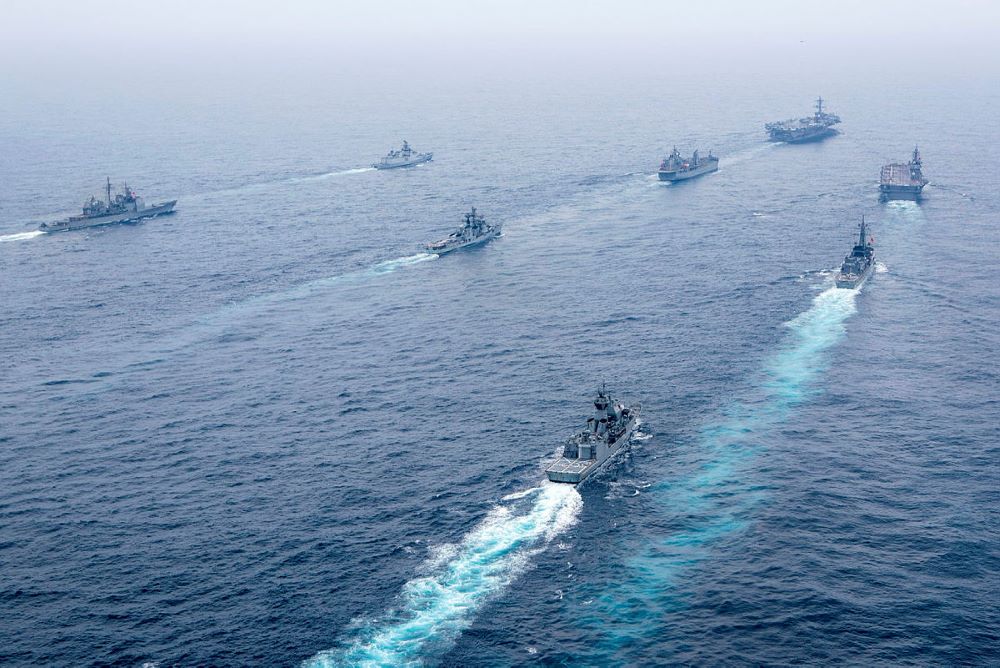
US President Theodore Roosevelt once said, ‘A good navy is not a provocation to war. It is the surest guaranty of peace’. Those poignant words were uttered in 1902 but they have a distinct relevance to the era in which we find ourselves now.
In 2007, the Royal Australian Navy’s guided missile frigate HMAS Adelaide executed manoeuvres in the northwest Indian Ocean alongside two aircraft carriers, INS Viraat and USS Kittyhawk. While naval exercises are a common part of an Australian ship’s program, this exercise was particularly important. The Adelaide’s manoeuvres alongside ships from India and the US represented Australia’s inaugural participation in Exercise Malabar.
Australia’s recent defence strategic review clearly outlined a strategy for deterrence by denial. There’s a genuine debate to be had on whether this concept is scalable to an appropriate maritime strategy for Australia. That was eloquently canvassed by pre-eminent Australian maritime strategist, the late James Goldrick, in a 2021 piece titled ‘Sea denial is not enough: an Australian and Indian perspective’, coauthored with Sudarshan Y. Shrikhande. Their argument is compelling and makes it clear that sea denial is unlikely to be a sufficient maritime strategy for Australia.
But the Royal Australian Navy does play a crucial role in this nation’s deterrence strategy. Effective deterrence is often considered to be underpinned by the three Cs—communication, capability and credibility.
Maritime tasks are generally grouped into three broad areas, military, constabulary and diplomatic. Naval exercises such as Malabar, which gets underway off Australia tomorrow, represent an important element of the naval diplomacy task, one that remains a consistent obligation of navies the world over, whatever the geostrategic context or technological advances. Within this context of deterrence communication, capability and credibility, naval diplomacy comes to the fore in Exercise Malabar.
Malabar originated as a bilateral exercise involving just the US and India in 1992. Conducted at irregular intervals, it had a renewed focus following the US entry into the global war on terror, after which it became a regular exercise. Following the inaugural Quadrilateral Security Dialogue in 2007, Exercise Malabar moved to the Bay of Bengal and incorporated Singapore, Japan and Australia. Building on its participation in the multilateral Indian-led Exercise Milan, the RAN’s engagement in Malabar in 2007 signalled an increasing maritime focus between the two Indian Ocean neighbours.
The 2007 iteration of Malabar sparked objections from China regarding the location and growth of the exercise. In 2008, the then prime minister, Kevin Rudd, stopped Australia’s participation in the exercise following a meeting with the Chinese foreign minister. Australia’s withdrawal from this key aspect of the Quad clearly struck a nerve with India. Australia spent many years trying to rejoin the exercise, but those efforts were reportedly regularly rebuffed by India.
In 2015, while on a visit to India, the then defence minister, Kevin Andrews, reiterated Australia’s willingness to rejoin the exercise. But no invitation was forthcoming. Japan joined the exercise in 2015, and in 2018 Tokyo expressed support for Australia’s inclusion, but to no avail. The consistent rejection of Australia’s efforts to rejoin Malabar came despite the establishment in 2015 of a bilateral exercise between Australia and India, AUSINDEX, and India’s inclusion in the Australian-led major multilateral Exercise Kakadu.
In the week in which Exercise Malabar is due to commence its first ever iteration of the exercise located in Australia – the history of this exercise is important. It’s more than just another naval exercise.
Australia’s withdrawal from the exercise, and India’s subsequent reluctance to allow it to rejoin, were clearly linked to China’s perception of both the exercise and the Quad. In 2020, Australia rejoined the exercise during a significant period of economic coercion from China and has been an annual participant in the three iterations since. Significantly, the 2020 exercise was executed in the Bay of Bengal—where it was held just before China’s original objection. It has since been held in the Philippine Sea, the East China Sea, and now off the coast of Australia.
Both the location and the very fact that Australia is participating are important. Despite the tumultuous history of Australia’s involvement in Malabar, this communicates a clear message that the Quad countries have the capability and, through the regularity and complexity of the exercise, the credibility to work together. This is essential to the defence strategic review’s deterrence strategy. Naval diplomacy and a credible RAN underpin this. Investing in our defence force, and particularly our navy, as Theodore Roosevelt remarked so long ago, is the surest way to guarantee a peaceful region.

